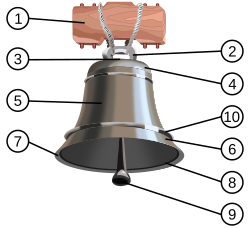Bell clapper

Parts of a typical tower bell hung for swinging: 1. yoke, or headstock 2. canons, 3. crown, 4. shoulder, 5. waist, 6. sound bow, 7. lip, 8. mouth, 9. clapper, 10. bead line
|
|
| Percussion instrument | |
|---|---|
| Classification | struck idiophone |
| Hornbostel–Sachs classification | 111.242 (Bells: Percussion vessels with the vibration weakest near the vertex) |
| Playing range | |
| From very high to very low | |
| Related instruments | |
| Chimes, Cowbell, Handbell, Gong | |
A bell is a directly struck idiophone percussion instrument. Most bells have the shape of a hollow cup that when struck vibrates in a single strong strike tone, with its sides forming an efficient resonator. The strike may be made by an internal "clapper" or "uvula", an external hammer, or—in small bells—by a small loose sphere enclosed within the body of the bell.
Bells are usually cast from bell metal (a type of bronze) for its resonant properties, but can also be made from other hard materials; this depends on the function. Some small bells such as ornamental bells or cow bells can be made from cast or pressed metal, glass or ceramic, but large bells such as church, clock and tower bells are normally cast from bell metal.
Bells intended to be heard over a wide area can range from a single bell hung in a turret or bell-gable, to a musical ensemble such as an English ring of bells, a carillon or a Russian zvon which are tuned to a common scale and installed in a bell tower. Many public or institutional buildings house bells, most commonly as clock bells to sound the hours and quarters.
Historically, bells have been associated with religious rituals, and are still used to call communities together for religious services. Later, bells were made to commemorate important events or people and have been associated with the concepts of peace and freedom. The study of bells is called campanology.
Bell is a word common to the Low German dialects, cognate with Middle Low German belle and Dutch bel but not appearing among the other Germanic languages except the Icelandic bjalla which was a loanword from Old English. It is popularly but not certainly related to the former sense of to bell (Old English: bellan, "to roar, to make a loud noise") which gave rise to bellow.
...
Wikipedia
